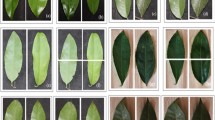Abstract
Wan-chak-motluk is a Thai local name for native species of Curcuma (Zingiberaceae) that produce phytoestrogen in their rhizomes. Wan-chak-motluk has long been used in Thai traditional medicine for treatment of illness in the uterus and ovarian hormone deficit, and therefore it is cultivated for economic purposes throughout Thailand. The rhizome morphology of wan-chak-motluk is highly variable and this may be related to its medicinal properties. Thus, this study aimed to identify and classify wan-chak-motluk collected from cultivation sites in 16 provinces of Thailand. Chromosome numbers, together with inflorescent, floral, and leaf morphology, were used to separate wan-chak-motluk into five cultivars belonging to three species: C. comosa, C. elata, and C. latifolia. Curcuma comosa has short (2–5 cm) peduncle, glabrous lower leaf, and consists of two cultivars. One cultivar has a cylindrical spike 13–17 cm long and 5–8 cm wide, whereas the cylindrical spike of the other cultivar is shorter (10–15 cm) but larger (8–12 cm). The former cultivar has 2n = 42 and the latter has 2n = 63, seldom 2n = 62 or 64. Both C. elata and C. latifolia have long (10–25 cm) peduncle and pubescent lower leaf. They differ in that C. latifolia has 2n = 63 and 84 with a red path along the midrib, whereas C. elata has 2n = 63 without a red path along the midrib. This study shows that chromosome numbers can be used to accurately verify the taxonomic identification of wan-chak-motluk.




Similar content being viewed by others
References
Sodsai A, Piyachaturawat P, Sophasan S, Suksamrarn A, Vongsakul M (2007) Suppression by Curcuma comosa Roxb. of pro-inflammatory cytokine secretion in phorbol-12-myristate-13-acetate stimulated human mononuclear cells. Int Immunopharm 7:524–531
Suksamrarn A, Ponglikitmongkol M, Wongkrajang K, Chindaduang A, Kittidanairak S, Jankam A, Yingyongnarongkul B, Kittikanumat N, Chokchaisiri R, Khetkam P, Piyachaturawat P (2008) Diarylheptanoids, new phytoestrogens from the rhizomes of Curcuma comosa: isolation, chemical modification and estrogenic activity evaluation. Bioorg Med Chem 16:6891–6902
Winuthayanon W, Piyachaturawat P, Suksamrarn A, Ponglikitmongkol M, Arao Y, Hewitt S, Korach KS (2009) Diarylheptanoid phytoestrogens isolated from the medicinal plant Curcuma comosa: biologic actions in vitro and in vivo indicate estrogen receptor-dependent mechanisms. Environ Health Perspect 117:1155–1161
Piyachaturawat P, Charoenpiboonsin J, Toskulkao C, Suksamrarn A (1999) Reduction of plasma cholesterol by Curcuma comosa extract in hypercholesterolaemic hamsters. J Ethnopharmacol 66:199–204
Jurgens TM, Frazier EG, Schaeffer JM, Jones TE, Zink DL, Borris RP, Nanakorn W, Beck HT, Balick MJ (1994) Novel nematocidal agents from Curcuma comosa. J Nat Prod 57:230–235
Tongpamnak P, Phatthanathara A, Yimyum B, Locharoen S (2005) DNA markers analysis for genetic diversity of Wan chak motluk (Zingiberaceae). Proc Sem Plant Resour Thailand, pp 346–351
Phupatanapong L, Chayamarit K, Buntaweekhun T (2001) Thai plant names by Tem Smitinand, 2nd edn. Prachachon, Bangkok, p 160
Paisooksativatana Y, Thepsen O (2001) Phenetic relationships of some Thai Curcuma species (Zingiberaceae) based on morphological, palynological and cytological evidence. Thai J Agric Sci 34:47–57
Joseph R, Joseph T, Joseph J (1999) Karyomorphological studies in genus Curcuma Linn. Cytologia 64:313–317
Islam MA (2004) Genetic diversity of the genus Curcuma in Bangladesh and further technological approaches for in vitro regeneration and long-term conservation of C. longa germplasm. PhD thesis, University of Hanover, Germany
Chen ZY, Chen SJ (1984) A report on chromosome numbers of Chinese Zingiberaceae. Guihaia 4:13–18
Apavatjrut P, Sirisawad T, Sirirugsa P, Voraurai P, Suwanthada C (1996) Studies on chromosome number of seventeen Thai Curcuma species. In: Proceedings of the 2nd national conference on flower and ornamental plant 2, pp 86–99
Ardiyani M (2002) Systematic study of Curcuma L.: turmeric and it allies. PhD thesis, University of Edinburgh, Scotland
Sirisawad T, Sirirugsa P, Suwanthada C, Apavatjrut P (2003) Investigation of chromosome numbers in 20 taxa of Curcuma. In: Chantaranothai P, Larsen K, Sirirugsa P, Simpson D (eds) Proceedings of the third symposium on the family Zingiberaceae, pp 54–62
Skornicova LJ, Sida O, Jarolimova V, Sabu M, Fer T, Travnicek P, Suda J (2007) Chromosome numbers and genome size variation in Indian species of Curcuma (Zingiberaceae). Ann Bot 100:505–526
Sasikumar B (2005) Genetic resources of Curcuma: diversity, characterization and utilization. Plant Genet Resour 3:230–251
Darlington CD, La Cour LF (1966) The handling of chromosomes. George Allen & Unwin, London, pp 43–49
Roxburgh W (1820) Monandria Monogynia. Flora Indica. Mission, Sarampore, pp 1–82
Roscoe W (1828) Monandrian plants of the order Scitamineae with 112 handcol. plates. Liverpool, pl. 18
Larsen K, Larsen SS (2006) Gingers of Thailand. Queen Sirikit Botanical Garden Organization, Ministry of Natural Resources and Environment, pp 76–85
Maknoi J (2006) Taxonomy and phylogeny of the genus Curcuma L. (Zingiberaceae) with particular reference to its occurrence in Thailand. Thesis, Prince of Songkla University
Ramachandran K (1961) Chromosome numbers in the genus Curcuma Linn. Curr Sci 30:194–196
Prana MS, Sastrapradja S, Hawkes JG, Lubis I (1978) A cytological study of some Indonesian Curcuma species. J Root Crops 4:31–35
Sirirugsa P (1999) Thai Zingiberaceae: species diversity and their uses. http://www.iupac.org/symposia/proceedings/phuket97/sirirugsa.html. Accessed 20 Aug 2009
Skornickova J, Sabu M (2005) The identity and distribution of Curcuma xanthorrhiza Roxb. (Zingiberaceae). Garden Bull Singapore 57:199–210
Acknowledgments
This work was supported by the National Research Council of Thailand (NRCT) and Mahidol University. We are most grateful to Prof. Kesara Anamthawat-Jonsson from the University of Iceland and Prof. Pawinee Piyachaturawat of Mahidol University for their valuable comments on the manuscript.
Author information
Authors and Affiliations
Corresponding author
Rights and permissions
About this article
Cite this article
Soontornchainaksaeng, P., Jenjittikul, T. Chromosome number variation of phytoestrogen-producing Curcuma (Zingiberaceae) from Thailand. J Nat Med 64, 370–377 (2010). https://doi.org/10.1007/s11418-010-0414-9
Received:
Accepted:
Published:
Issue Date:
DOI: https://doi.org/10.1007/s11418-010-0414-9




